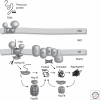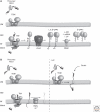Quality control of mitochondrial proteostasis
- PMID: 21628427
- PMCID: PMC3119916
- DOI: 10.1101/cshperspect.a007559
Quality control of mitochondrial proteostasis
Abstract
A decline in mitochondrial activity has been associated with aging and is a hallmark of many neurological diseases. Surveillance mechanisms acting at the molecular, organellar, and cellular level monitor mitochondrial integrity and ensure the maintenance of mitochondrial proteostasis. Here we will review the central role of mitochondrial chaperones and proteases, the cytosolic ubiquitin-proteasome system, and the mitochondrial unfolded response in this interconnected quality control network, highlighting the dual function of some proteases in protein quality control within the organelle and for the regulation of mitochondrial fusion and mitophagy.
Figures





Similar articles
-
Quality control of the mitochondrion.Dev Cell. 2021 Apr 5;56(7):881-905. doi: 10.1016/j.devcel.2021.02.009. Epub 2021 Mar 3. Dev Cell. 2021. PMID: 33662258 Review.
-
Mitochondria-Associated Degradation Pathway (MAD) Function beyond the Outer Membrane.Cell Rep. 2020 Jul 14;32(2):107902. doi: 10.1016/j.celrep.2020.107902. Cell Rep. 2020. PMID: 32668258 Free PMC article.
-
Control of mitochondrial biogenesis and function by the ubiquitin-proteasome system.Open Biol. 2017 Apr;7(4):170007. doi: 10.1098/rsob.170007. Open Biol. 2017. PMID: 28446709 Free PMC article. Review.
-
Inhibition of proteasome reveals basal mitochondrial ubiquitination.J Proteomics. 2020 Oct 30;229:103949. doi: 10.1016/j.jprot.2020.103949. Epub 2020 Aug 31. J Proteomics. 2020. PMID: 32882436
-
Mitochondrial protein homeostasis: the cooperative roles of chaperones and proteases.Res Microbiol. 2009 Nov;160(9):718-25. doi: 10.1016/j.resmic.2009.08.003. Epub 2009 Aug 31. Res Microbiol. 2009. PMID: 19723579 Review.
Cited by
-
Mitochondrial fission, fusion, and stress.Science. 2012 Aug 31;337(6098):1062-5. doi: 10.1126/science.1219855. Science. 2012. PMID: 22936770 Free PMC article. Review.
-
Small heat shock proteins operate as molecular chaperones in the mitochondrial intermembrane space.Nat Cell Biol. 2023 Mar;25(3):467-480. doi: 10.1038/s41556-022-01074-9. Epub 2023 Jan 23. Nat Cell Biol. 2023. PMID: 36690850 Free PMC article.
-
Bioabsorbable metal zinc differentially affects mitochondria in vascular endothelial and smooth muscle cells.Biomater Biosyst. 2021 Aug 26;4:100027. doi: 10.1016/j.bbiosy.2021.100027. eCollection 2021 Dec. Biomater Biosyst. 2021. PMID: 36824572 Free PMC article.
-
The different axes of the mammalian mitochondrial unfolded protein response.BMC Biol. 2018 Jul 26;16(1):81. doi: 10.1186/s12915-018-0548-x. BMC Biol. 2018. PMID: 30049264 Free PMC article. Review.
-
Peroxisome Proliferator-Activated Receptor α Attenuates Hypertensive Vascular Remodeling by Protecting Vascular Smooth Muscle Cells from Angiotensin II-Induced ROS Production.Antioxidants (Basel). 2022 Nov 30;11(12):2378. doi: 10.3390/antiox11122378. Antioxidants (Basel). 2022. PMID: 36552585 Free PMC article.
References
-
- Anesti V, Scorrano L 2006. The relationship between mitochondrial shape and function and the cytoskeleton. Biochim Biophys Acta 1757: 692–699 - PubMed
-
- Arlt H, Tauer R, Feldmann H, Neupert W, Langer T 1996. The YTA10-12 complex, an AAA protease with chaperone-like activity in the inner membrane of mitochondria. Cell 85: 875–885 - PubMed
-
- Arnold I, Wagner-Ecker M, Ansorge W, Langer T 2006. Evidence for a novel mitochondria-to-nucleus signalling pathway in respiring cells lacking i-AAA protease and the ABC-transporter Mdl1. Gene 367: 74–88 - PubMed
-
- Augustin S, Nolden M, Muller S, Hardt O, Arnold I, Langer T 2005. Characterization of peptides released from mitochondria: Evidence for constant proteolysis and peptide efflux. J Biol Chem 280: 2691–2699 - PubMed
Publication types
MeSH terms
Substances
LinkOut - more resources
Full Text Sources
